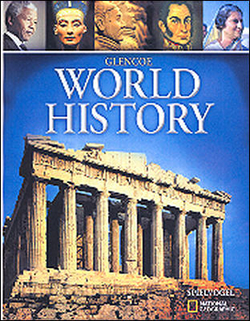Glencoe World History © 2010Chapter 5:
Rome and the Rise of ChristianityChapter OverviewsAncient Rome ruled the Mediterranean and developed a system of law and justice that is still recognized today. Increasing internal instability eventually transformed the Roman Republic into the Roman Empire. Weakened by internal unrest and plagued by invaders, Rome collapsed in 410 A.D. Section 1 The Rise of Rome
Geography greatly influenced the development of Rome, which was strategically situated inland on hills along the Tiber River. In 509 B.C., the Romans overthrew the last Etruscan king and established a republic. Wealthy patrician landowners in the Roman Senate dominated the early republic. Plebeians voted and served in the army, but they could not marry patricians or be elected. In 287 B.C., all male Roman citizens were proclaimed equal under the law. Rome never truly became a democracy, but it did develop a code of laws and standards of justice that have influenced many legal systems. Over several centuries, Rome brought most of Italy under its control. It then confronted Carthage, its main rival in the Mediterranean, during the Punic Wars. In the Third Punic War, Rome finally defeated Carthage. By 129 B.C., Rome dominated the Mediterranean region. Section 2 From Republic to Empire
By the second century B.C., aristocrats in the Senate dominated the Roman state. Meanwhile, many small farmers could no longer compete and became landless poor. Some leaders called for land reform to address the problem. However, the aristocrats resisted such pressures, and the republic faced a period of civil war. The First Triumvirate placed power in the hands of three wealthy generals. One of these generals, Julius Caesar, marched on Rome with his troops, and eventually he was declared dictator. Caesar's rule ended when he was assassinated. Following a Second Triumvirate, Octavian became the first Roman Emperor, Augustus, and the civil wars came to an end. Section 3 Roman Culture and Society
The Romans adopted many features of Greek culture. They also developed their own realistic style of sculpture, introduced the use of concrete in construction, and displayed impressive feats of engineering in their roads, bridges, and aqueducts. The Age of Augustus was the high point of Latin Literature. In early Rome the male head of household had absolute authority over the family. By the third century B.C., women enjoyed increasing independence and a more visible—if unequal—social role. Slavery was commonplace, although slaves occasionally revolted. In the most famous case, a revolt of 70,000 slaves lasted two years before being crushed. The small town of Rome grew into a thriving, overcrowded city. There was an enormous gulf between rich and poor. Yet Rome's public buildings, public works, and public entertainment provided a sense of grandeur and magnificence. Section 4 The Development of Christianity
Roman religion worshipped many gods and goddesses. Romans were initially tolerant of other religions. By 6 A.D., there was widespread unrest in Judaea about Roman rule. Christianity emerged at a time of widespread unrest in the Roman province of Judaea. Christianity began as a religious movement within Judaism which spread following Jesus' death. By 100 A.D. Christian churches were established in many major cities of the empire. Romans, despite a history of tolerance of many religions, viewed Christianity as a threat to the state, and Christians often faced persecution. In the fourth century, the emperor Constantine proclaimed official tolerance of Christianity, setting the stage for its adoption as the empire's official religion under Theodosius the Great. Section 5 Decline and Fall
Conflict and confusion followed the death of Marcus Aurelius, the last of the five good emperors. Invasions, civil wars, and plague brought the empire to the brink of economic collapse. Diocletian and Constantine restored at least temporary stability to the empire by using a combination of political and economic reforms, coercion, and stringent economic and social policies. Diocletian deemed the empire too large for one emperor and divided it into four units, each with its own ruler. The Greek city of Byzantium became the capital of the eastern part of the empire, while invading Germanic tribes put increasing pressure on the western part of the empire. Later Rome was sacked by two invading tribes, first the Visigoths, then the Vandals. The western emperor, Romulus Augustulus, was deposed by the Germanic head of the Roman army in 476, marking the fall of the Western Roman Empire.  | 
















